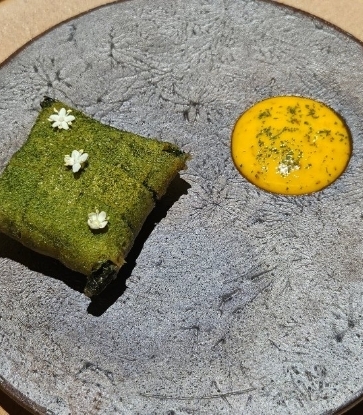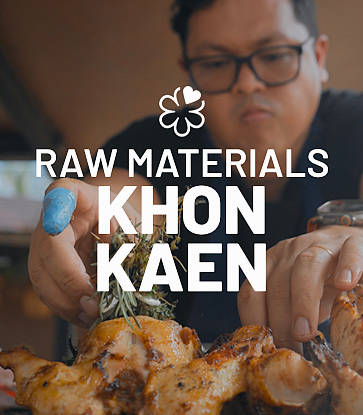“Liberté, Egalité, Fraternité”. Ask any Frenchman what it means to be French and these three words will most likely to be uttered in the same breath. Just as this national motto has remained the nation’s pillars of strength, Thailand’s “Chat, Sasana, Pramahakasat” (Nation, Religion, Monarchy) lie at the very heart of what it means to be Thai.
It’s hardly surprising then, that major Buddhist holidays, religious ceremonies and the preparation of food offerings would make up the very fabric of Thai society. So what does a religious holiday like Asalahabucha Day (this year marked on 27 July) mean for the free-spirited, fun-loving Thais? It means abstaining from alcohol and immoral acts, going to the temple to make merit and giving alms to monks.

Buddhism beyond Bangkok
Alms-giving or tak baat is one of the most common ways to make merit for Buddhists in Thailand. By giving, they believe that good things await them in the afterlife. In provincial areas, the traditional way of doing this is still very much the norm. Old ladies get up at the break of dawn to cook rice and prepare fresh ingredients that will be used to cook meals for the monks. These are carefully wrapped in either banana, pandan or lotus leaves and placed inside an alms bowl carried by the monks as they walk by laymen’s homes.
This act of giving brings families together for a common cause and it’s an occasion where light-hearted conversation amongst loved ones take place whilst cooking in the name of Buddhism. In this instance, food is the mesh that holds together all components of society – as if by some divine act, friends, family, faith and community momentarily become one. This unique albeit dying tradition of merit-making is not only heartwarming to see, but is one that exists nowhere else on Earth.
In Thailand’s rural provinces where life moves along at the pace of a water buffalo ploughing the fields, locals take their time to prepare the offerings. On a major Buddhist holiday, rather than giving alms, families walk to the temple with food they’d prepared themselves neatly tucked in a “pinto” or tiffin.

Food for the soul
So exactly what kind of food does one offer to ensure a fast track to heaven? That’s the million-dollar question no Buddhist has ever been able to answer. In provincial Thailand, “taam mee taam kerd” or “whatever is available and affordable” is a saying that would best define the tradition. Whatever it is they’re enjoying at home, a portion of each dish would be scooped aside ready for the monks. Very popular are fish-based meals such as grilled catfish, deep-fried snakehead fish or tilapia – all freshwater fish found in abundance in the Kingdom. More basic dishes such as kai jiew or Thai omelette with chilli paste dip (nam prik), some steamed eggplants, longbeans and slices of cucumber are all-time favourites. Not only are they easy to ingest, they’re also a boon for the digestive system.
Families with time and money on their hands will sometimes go to extremes to prepare a feast - fried rice with crabmeat, beef massamun curry slow-cooked to perfection, perhaps capped off with a set of intricately carved fruits such as melons, papaya or dragon fruit. Some Buddhists believe that the more elaborate the offering, the more beautiful they will be in their next life. Forget a fast track to heaven, a fast track to arresting good looks sounds like a sweeter deal!


A grain of thought
If rice is the heart of Thai cuisine, it’s also the soul of alms-giving. Hardly surprising then that Thailand is the world’s second largest exporter of rice. Freshly-cooked grains are almost always donated to monks alongside other offerings. If a layman can’t afford the ingredients with which to prepare a meal for the monks, then a spoonful of rice would be deemed just as meritorious. In most parts of the country, jasmine or hom mali rice (the Ferrari of rice grains) is preferred, while in the north and northeastern regions, sticky rice or khao niew is more commonly used.

How to give alms
Buddhist monks rely solely on food donations from the people. They typically leave the monasteries at the crack of dawn with alms bowls with which to receive donations until 7am. Although food is the most common donation made, some devout Buddhists also donate flowers and incense sticks.
“Tung jit atitaan”. This means to focus, to clear your mind of all thoughts and concentrate only on this deed. Pray that this merit will be passed on to loved ones who have departed and to yourself in the afterlife.
When giving alms to monks, laymen must remove their shoes.
Food offered as alms should be of high quality. The rice should be steaming – it’s a belief that the warmer the rice, the higher the merit; the meat in the offering should not have been acquired specifically for the purpose of making offerings to monks.

Where and when
Friends of all faiths are welcome to give alms to Buddhist monks. Monks rely on offerings from laymen for food so observe which temple is closest to you and ask the locals to advise you on best location to wait for the monks to walk past. Some monks go out on their alms round as early as 5am but they must all return to the temple by 7am for prayers.
Some of the major temples in Bangkok where you can give alms to monks include Wat Benhamabophit, Wat Pho, Wat Arun and Wat Mahathat.





















